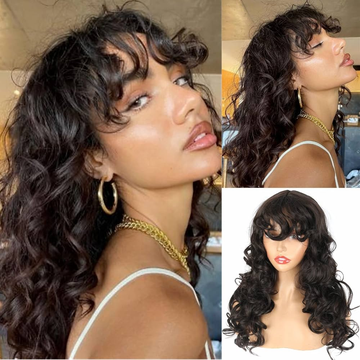Trendy ideas to inspire your next look
If you have curly hair, you know that styling it—or trying to nail a unique look—can sometimes feel… awkward. But there’s one haircut that’s making waves (sorry, puns will never die) for all the right reasons. The curly wolf cut hairstyle blends shaggy layers with mullet-inspired flair, giving your hair incredible texture, volume, and movement. It’s the ultimate choice for anyone ready to embrace their natural curls while making a bold statement.
What sets the wolf cut apart for curly hair is its ability to enhance the natural bounce of your curls while reducing bulk. From loose waves to tight coils, this layered style is versatile, low-maintenance, and effortlessly cool. It’s the kind of cut that turns heads without even trying.
If you’ve been searching for inspiration to rock wolf cuts for curly hair, here it is. From styling tips to creative variations, you’ll learn to take your curls to the next level.
What is a wolf cut?
The wolf cut is a trendy hairstyle featured on TikTok that merges the best of two iconic looks: the shag and the mullet. Characterized by its choppy layers, volume at the crown, and tapered ends, it’s a style that’s bold, edgy, and effortlessly cool. The wolf cut offers a mix of texture and movement, making it a versatile choice for a variety of hair types.
While traditionally associated with straight hair, the curly wolf cut hairstyle takes this trend to the next level by enhancing the natural bounce and definition of curls. It’s a low-maintenance, high-impact cut that embraces an undone, carefree vibe while maintaining shape and structure. Perfect for anyone looking to add personality and flair to their look, it never goes out of style.
Why does the wolf cut work for curly hair?
The wolf cut is practically made for curly hair, and here’s why.
– Enhances natural texture: The choppy layers of the wolf cut work in harmony with curls to create movement and definition. Unlike blunt cuts, which can weigh curls down, the wolf cut allows each strand to bounce freely, highlighting your hair’s natural shape.
– Reduces bulk: Curly hair can sometimes feel heavy, especially around the crown and ends. The strategic layering of the wolf cut helps remove excess bulk while keeping the volume where it matters most—at the crown and throughout the mid-lengths.
– Flattering for all curl types: Whether you have loose waves, spirals, or tight coils, the curly wolf cut hairstyle can be tailored to suit your unique curl pattern. The layers bring out the best in every curl type, making your hair look effortlessly styled even on low-maintenance days.
– Perfectly undone vibe: One of the wolf cut’s biggest appeals is its carefree, slightly messy aesthetic. Curly hair naturally lends itself to this look, as its texture adds depth and dimension to the layers without requiring much effort.
– Customizable for face shapes: The wolf cut can be adapted to flatter different face shapes. For example, shorter layers can add width to longer faces, while longer layers can soften rounder ones. For curly hair, these adjustments are even more impactful, as they draw attention to your curls and frame your features beautifully.
Whether you’re embracing your natural hair texture or looking for a cut that feels edgy and unique, the wolf cuts for curly hair trend checks every box. It’s low-maintenance, high-style, and undeniably cool.
Who should avoid the wolf cut?
While the wolf cut is a versatile and trendy hairstyle, it’s not the perfect fit for everyone. Certain hair types and personal preferences might make this style less ideal. Here’s a breakdown of who might want to think twice before committing to a wolf cut:
1. Those with very thin or fine hair
If your hair is naturally thin or lacks volume, the wolf cut may not deliver the dramatic texture and fullness it’s known for. The choppy layers could make thin hair appear even sparser, which might leave you feeling underwhelmed.
Alternative: Opt for a more structured cut with soft layers that add body without sacrificing density.
2. People who prefer sleek, polished styles
The wolf cut thrives on an undone, slightly messy aesthetic. If you’re someone who loves sleek, straight hair or ultra-polished looks, the carefree vibe of the wolf cut may not align with your styling preferences.
Alternative: Consider a blunt bob or lob, which offers clean lines and a more refined finish.
3. Those uncomfortable with regular maintenance
While the wolf cut is considered low-maintenance in terms of daily styling, it does require regular trims to maintain its shape. If you’re not willing to visit the salon every 6–8 weeks, the layers may grow out unevenly, losing the cut’s signature appeal.
Alternative: A one-length cut or a soft, blended layer style requires less frequent upkeep.
4. People who dislike short layers
The wolf cut often includes shorter layers around the crown, which create its signature volume and texture. If you’re not a fan of shorter pieces or find them hard to manage, this style might not be for you.
Alternative: A longer layered cut can give you some movement without the shorter, choppy layers.
5. Curly hair with excessive shrinkage
For those with tight coils or curls that shrink significantly when dry, the wolf cut might not give the desired shape or length. Shorter layers can sometimes make highly textured hair look uneven or harder to control.
Alternative: A tailored cut with longer layers can enhance your curls without the unpredictability of shrinkage.
Top curly wolf cut hairstyles
The beauty of the curly wolf cut hairstyle lies in its versatility. No matter your curl type or personal aesthetic, there’s a variation of this cut that will suit you perfectly. Here are some trendy ideas to consider:
1. Long-layered wolf cut
This version keeps the length while incorporating layers throughout the crown and mid-lengths to add movement. Ideal for those who love their long curls but want a more modern edge.
Styling tip: Use a diffuser to enhance volume and define layers, then finish with a light-hold curl cream to keep frizz in check.
2. Short and shaggy wolf cut
For those who want something bold and edgy, the short wolf cut is a statement-maker. The shorter layers frame the face, while the shaggy texture keeps the look fresh and fun.
Styling tip: Apply a curl-enhancing mousse and scrunch your hair while drying to bring out the texture.
3. Asymmetrical wolf cut
This cut adds a unique twist by featuring uneven layers for a more dynamic and eye-catching look. It’s perfect for those who like to experiment with their style.
Styling tip: Use a defining gel to separate and highlight the layers for extra dimension.
4. Wolf cut with bangs
Pairing the wolf cut with bangs—whether curtain or full—can elevate the style while drawing attention to your eyes. This works especially well for oval and round face shapes.
Styling tip: Blow-dry your bangs with a small round brush and apply a touch of serum for a polished finish.
How to style and maintain a curly wolf cut
Styling and maintaining the curly wolf cut hairstyle is easier than you might think. The key is to embrace your curls’ natural texture while using the right products and techniques.
Styling your wolf cut
- Start with clean, hydrated hair. Use a sulfate-free shampoo and a rich conditioner to keep your curls nourished and defined.
- Apply a leave-in conditioner. To prevent frizz and maintain moisture, apply a curl-specific leave-in conditioner to damp hair.
- Use a diffuser. Dry your hair with a diffuser attachment to enhance volume and minimize frizz. Flip your hair upside down for added lift at the roots.
- Define with a styling product. Depending on your preference, use a curl cream, gel, or mousse to shape and hold your curls. Scrunch your hair gently to create more definition.
Maintaining your wolf cut
– Get regular trims. Schedule a trim every 6–8 weeks to maintain the shape and prevent split ends.
– Use deep conditioning treatments. Treat your curls to a deep conditioning mask once a week to keep them hydrated and strong.
– Protect your hair at night. Use a silk or satin pillowcase to reduce friction and maintain your curls’ integrity. You can also tie your hair in a loose pineapple bun to prevent tangles.
DIY and natural options for achieving a wolf cut look
If you’ve got some experience with cutting your own hair, you can create a DIY version of the curly wolf cut hairstyle at home with the right tools and techniques. You should only do this if you feel comfortable, we wouldn't recommend you choose this style for a first time haircut!
DIY wolf cut tips
– Start with damp hair. Damp hair is easier to manage and ensures even cutting.
– Section your hair. Divide your hair into manageable sections, starting with the crown. Use clips to hold the rest of your hair out of the way.
– Point-cutting technique. Use sharp scissors to snip into the ends of each section at an angle. This creates soft, natural-looking layers.
– Focus on the crown. Add shorter layers to the crown area to achieve the signature volume and shape of the wolf cut.
Natural styling options
If you prefer a heat-free approach, here are some natural ways to style your wolf cuts for curly hair.
– Plopping: Wrap your damp hair in a cotton T-shirt or microfiber towel to enhance curl definition without frizz.
– Air-drying with a curl cream: Apply a lightweight curl cream and let your hair air-dry for a soft, natural finish.
– Twist-outs: Divide your hair into small sections, twist each one, and let it dry. Undo the twists for defined, bouncy curls that complement your layers.
Bring out your inner trendsetter with the curly wolf cut
By now you know that the curly wolf cut hairstyle is a statement. With its layered structure and edgy vibe, it’s the perfect way to embrace your natural curls while showcasing your individuality. Whether you opt for a long and layered version, a bold short cut, or a unique twist like asymmetry or bangs, the wolf cut offers endless possibilities to suit your style.
With the right care and styling techniques, you can rock this look effortlessly and turn heads wherever you go. So why not take the plunge? Consult your stylist to find your inner trendsetter.





